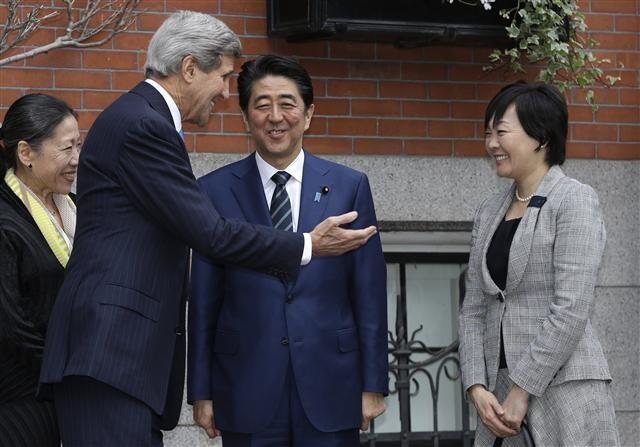hankyoreh
Links to other country sites 다른 나라 사이트 링크
Amendment of guidelines means closer US-Japan military cooperation

Japanese Prime Minister Shinzo Abe explained in a Wall Street Journal interview on Apr. 27 what Japan’s expanded military role and tighter military coordination with the US would mean after a recent amendment of the two countries’ defense cooperation guidelines.
“If there was an attack against the U.S. [Aegis] destroyer [near Japan], Japan would not be able to prevent that from happening under the current law,” Abe said in the interview. “In the future, the Japanese Aegis destroyer will be able to protect the U.S. Aegis destroyer.”
The chief outcome of the amended guidelines, which were confirmed by the US and Japanese foreign and defense ministers at a Security Consultative Committee on the first day of Abe’s US visit on Apr. 27, is the worldwide expansion of the scope of areas where the Japan Self-Defense Forces (JSDF) can offer rear-area support to the US and other countries’ forces.
The category of “situations endangering Japan’s existence” mentioned in the guidelines refers to scenarios where Japan would be allowed to exercise its collective self-defense rights by using military force even though not under attack itself. Specific examples listed include the weapon (asset) defense for US warships, minesweeping to ensure maritime transportation security, response operations to a missile attack, and preventing marine vessel activity in support of enemies.
The terms confirm the aim of the guideline amendment: to beef up cooperation on missile defense and crude oil transportation route security.
The existing guidelines specify three stages of situations in which the US and Japan are to cooperate militarily: normal circumstances, situations in areas surrounding Japan (including the Korean Peninsula and Taiwan), and armed attack against Japan. The new guidelines separate them further into peacetime (including gray zone situations), situations with an “important influence,” situations threatening Japan’s existence (in which the exercise of collective self-defense would be allowed), and armed attack against Japan. It’s a fleshing out of the “airtight preparations” Japan has stressed in the past.
Even more noteworthy is the proactive stances from both Washington and Tokyo. Their interim report on the guidelines last October stated that the revision “fully accords with both countries’ strategic goals and interests.” The latest version goes even further, stressing the need for coordination across governments within the alliance for the sake of security and defense cooperation. Indeed, the two countries are planning to establish an “alliance coordination mechanism” - which would also be available during peacetime - to achieve this.
Japan‘s Asahi Shimbun newspaper recently reported that the US and Japan were planning to set up a “joint coordination center,” with the USFJ sending liaison officers to the Japanese Defense Ministry’s central command and the JSDF sending its own officers to USFJ‘s Yokoda Air Base. It’s an important first step in giving the US-Japan alliance the same integration as the South Korea-US alliance, which maintains a Combined Forces Command.
A joint statement issued by members of the US and Japanese Cabinets on Apr. 27 offers more specifics on what kinds of activities the two countries will be involved in going ahead. The US announced plans to deploy more of its state-of-the-art weaponry to “contribute to alliance deterrence and the security of Japan and the Asia-Pacific region,” including the advanced Navy P-8 aircraft, the high-altitude unmanned Global Hawk surveillance aircraft, the USS Green Bay amphibious transport dock, the top-of-the-line Marine F-35B stealth fighter, and two Aegis vessels. Further terms included the replacement of the USS George Washington aircraft carrier at Yokosuka Naval Base with the USS Ronald Reagan. The plan is to focus these state-of-the-art US military resources in Japan as a way of monitoring Chinese activity in the East and South China Seas and beefing up the missile defense posture.
Originally drafted in 1979 as a measure against the threat of a Soviet invasion, the guidelines were previously amended in 1997 after the first North Korean nuclear crisis. The new revision comes 18 years later as a way of strengthening the US-Japan alliance into a global framework to reflect the geopolitical change of China‘s ascendance.
By Gil Yun-hyung, Tokyo correspondent
Please direct questions or comments to [english@hani.co.kr]

Editorial・opinion
![[Column] Life on our Trisolaris [Column] Life on our Trisolaris](https://flexible.img.hani.co.kr/flexible/normal/500/300/imgdb/original/2024/0505/4817148682278544.jpg) [Column] Life on our Trisolaris
[Column] Life on our Trisolaris![[Editorial] Penalties for airing allegations against Korea’s first lady endanger free press [Editorial] Penalties for airing allegations against Korea’s first lady endanger free press](https://flexible.img.hani.co.kr/flexible/normal/500/300/imgdb/original/2024/0502/1817146398095106.jpg) [Editorial] Penalties for airing allegations against Korea’s first lady endanger free press
[Editorial] Penalties for airing allegations against Korea’s first lady endanger free press- [Editorial] Yoon must halt procurement of SM-3 interceptor missiles
- [Guest essay] Maybe Korea’s rapid population decline is an opportunity, not a crisis
- [Column] Can Yoon steer diplomacy with Russia, China back on track?
- [Column] Season 2 of special prosecutor probe may be coming to Korea soon
- [Column] Park Geun-hye déjà vu in Yoon Suk-yeol
- [Editorial] New weight of N. Korea’s nuclear threats makes dialogue all the more urgent
- [Guest essay] The real reason Korea’s new right wants to dub Rhee a founding father
- [Column] ‘Choson’: Is it time we start referring to N. Korea in its own terms?
Most viewed articles
- 1New sex-ed guidelines forbid teaching about homosexuality
- 2OECD upgrades Korea’s growth forecast from 2.2% to 2.6%
- 3[Column] Life on our Trisolaris
- 460% of young Koreans see no need to have kids after marriage
- 5Months and months of overdue wages are pushing migrant workers in Korea into debt
- 6[Guest essay] Maybe Korea’s rapid population decline is an opportunity, not a crisis
- 7Presidential office warns of veto in response to opposition passing special counsel probe act
- 8Is Japan about to snatch control of Line messenger from Korea’s Naver?
- 9Bills for Itaewon crush inquiry, special counsel probe into Marine’s death pass National Assembly
- 10Hybe-Ador dispute shines light on pervasive issues behind K-pop’s tidy facade